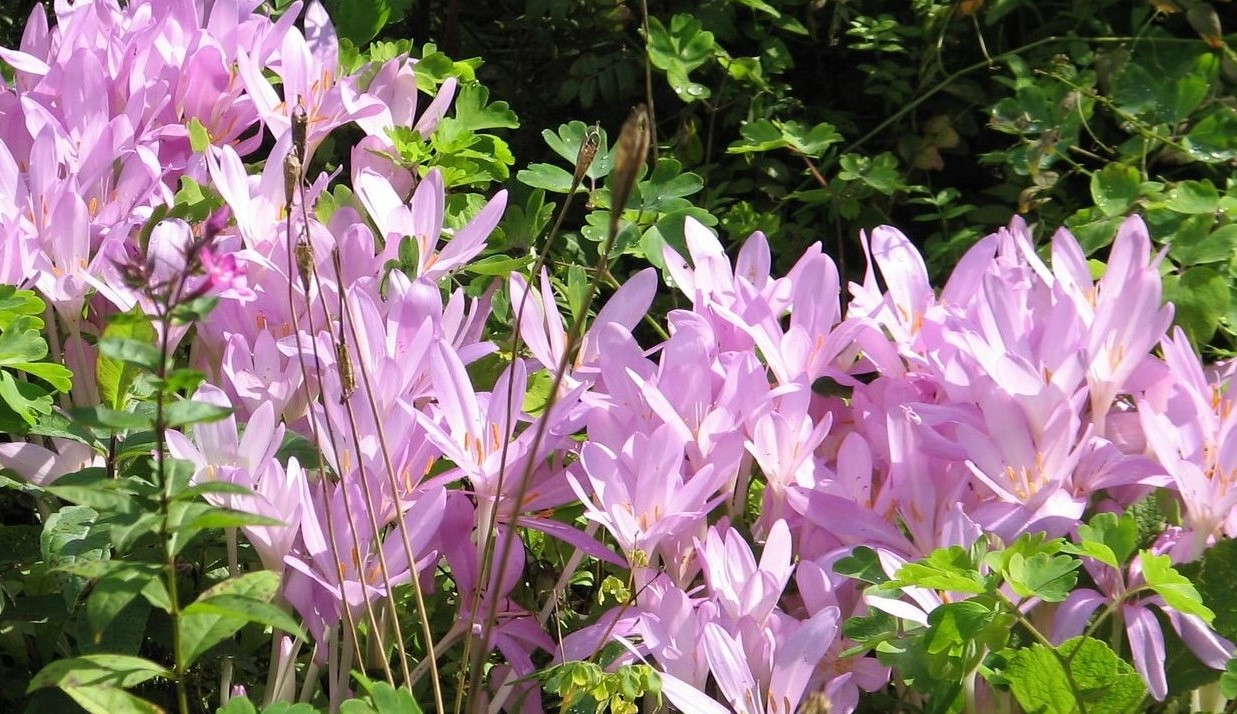
Colchicum, commonly known as autumn crocus or meadow saffron, is a fascinating plant with a rich history and a plethora of remarkable properties. This perennial bulbous plant is renowned for its vibrant flowers that bloom in autumn, adding a burst of color to gardens and landscapes. However, there is more to colchicum than meets the eye.
In this article, we will explore 16 unbelievable facts about colchicum that will leave you in awe of this unique plant. From its medicinal uses to its unusual growth patterns, get ready to delve into the world of colchicum and discover the fascinating secrets it holds. So, buckle up and prepare to be amazed by the wonders of colchicum!
Key Takeaways:
- Colchicum plants are not only stunning but also possess magical properties, such as the ability to bloom before producing leaves, making them a unique and captivating addition to any garden.
- Despite their enchanting beauty, it’s important to handle Colchicum plants with caution as all parts of the plant contain toxic compounds, emphasizing the need to appreciate their beauty from a safe distance.
The Origin of Colchicum
Colchicum, commonly known as the autumn crocus, is a stunning flowering plant native to Europe, Asia, and North Africa. With over 90 different species, Colchicum plants have graced gardens and landscapes for centuries.
The Mysterious Magical Compound: Colchicine
One of the most fascinating aspects of Colchicum plants is the presence of colchicine, a natural compound found in its bulbs and seeds. Colchicine has amazed scientists with its powerful medicinal properties and has been used in the treatment of gout, cancer, and even as an ingredient in plant breeding.
Colchicum: A Flower with the Power to Reverse Time
One unbelievable fact about Colchicum is its ability to defy the conventional order of growth. While most plants grow from the ground up, Colchicum plants have the unique quality of producing flowers before leaves. It’s like rewinding time and witnessing nature’s magic.
The Deadly Beauty of Colchicum
Beneath the enchanting beauty lies a dangerous secret. All parts of Colchicum plants, including the flowers, leaves, and bulbs, contain toxic compounds. Ingesting them can lead to severe illness and even death. Handle with caution!
The Time-Traveling Blooms: Dormancy and Resurrection
Colchicum plants exhibit a captivating form of dormancy. They lay dormant underground for several months, only to spring back to life with vibrant blooms during the autumn, seemingly out of nowhere. Witness the resurrection of nature!
Colchicum: Nature’s Thermostat
Colchicum plants are highly sensitive to temperature changes. They have the uncanny ability to adjust their growth and flowering patterns based on the temperature variations during different seasons. Truly nature’s own thermostat!
The Legends and Lore Surrounding Colchicum
Colchicum plants have inspired numerous myths and legends throughout history. In Greek mythology, they are associated with the story of Colchis, a region renowned for its magical herbs. It is believed that the sorceress Medea used Colchicum to possess mystical powers.
Colchicum: A Symbol of Rejuvenation
In many cultures, Colchicum is considered a symbol of rejuvenation and new beginnings. Its ability to bloom during the autumn, a season of change and transition, represents the cycle of life and the promise of a fresh start.
The Extraordinary Diversity of Colchicum Species
Colchicum encompasses a wide range of species, each with its own unique characteristics. From the delicate Colchicum autumnale with its pale pink flowers to the vibrant Colchicum speciosum with its deep purple blooms, there is a Colchicum plant to suit every taste and garden style.
Colchicum: A Feast for the Pollinators
The charming flowers of Colchicum are a delightful treat for pollinators such as bees and butterflies. As they flock to the nectar-rich blooms, they inadvertently aid in the plant’s reproduction by carrying pollen from one flower to another.
The Journey from Colchicum to Saffron
Interestingly, Colchicum plays a significant role in the production of saffron, the world’s most expensive spice. The plant Crocus sativus, which produces saffron, is closely related to Colchicum and is sometimes mistakenly referred to as the autumn crocus.
Colchicum: A Seasonal Surprise
For those unaware of its unique blooming pattern, encountering a field of Colchicum during autumn can be a delightful surprise. The sudden burst of vibrant colors amidst the fading landscape is a sight to behold.
Colchicum: A Resilient Survivor
Colchicum has the remarkable ability to withstand harsh conditions. From sandy soils to woodland areas, it adapts to various environments and remains resilient in the face of adversity.
Colchicum in Art and Culture
The stunning beauty of Colchicum has been a favorite subject for artists and poets. Its delicate petals and vibrant hues have been captured in paintings, photographs, and lyrical verses, immortalizing its allure in human creativity.
Colchicum: A Testament of Time
Colchicum has stood the test of time, captivating generations with its remarkable traits. Its enduring presence in gardens and landscapes serves as a testament to its enduring beauty and significance in the botanical world.
Preserving the Legacy of Colchicum
As we uncover the astonishing world of Colchicum plants, it is important to ensure their preservation. Through cultivation, conservation efforts, and raising awareness, we can contribute to the safeguarding of these incredible botanical wonders for future generations to appreciate.
Discover the remarkable world of Colchicum and indulge in the beauty and intrigue of these fascinating plants. Explore their unique characteristics, unearth their secrets, and embrace the wonder of nature’s artistry.
Remember, Colchicum is more than just a flower; it holds a world of wonders.
Conclusion
In conclusion, Colchicum, also known as “autumn crocus” or “meadow saffron,” is a fascinating plant with a rich history and several remarkable characteristics. From its vibrant flowers to its medicinal properties, Colchicum continues to captivate plant enthusiasts and researchers alike.As we have learned, Colchicum is not a true crocus, but it belongs to the family Colchicaceae. It blooms in the autumn, providing a burst of color when most other plants are starting to fade. Its ability to thrive in adverse conditions, such as poor soil and low light, makes it a resilient addition to any garden.Furthermore, Colchicum has been used in traditional medicine for centuries, particularly for its anti-inflammatory properties. However, caution must be exercised as some parts of the plant are highly toxic if ingested.In short, the world of plants never ceases to amaze us, and Colchicum is no exception. Its unique characteristics and historical significance make it a truly outstanding plant worth exploring and appreciating.
FAQs
Q: What is Colchicum?
A: Colchicum, also known as “autumn crocus” or “meadow saffron,” is a flowering plant that belongs to the family Colchicaceae.
Q: When does Colchicum bloom?
A: Colchicum typically blooms in the autumn, providing a burst of color when most other plants are beginning to fade.
Q: Is Colchicum a true crocus?
A: No, Colchicum is not a true crocus, but it is often referred to as such due to its similar appearance.
Q: Can Colchicum tolerate adverse conditions?
A: Yes, Colchicum is known to thrive in poor soil and low-light conditions, making it a resilient plant.
Q: Does Colchicum have any medicinal properties?
A: Yes, Colchicum has been used in traditional medicine for its anti-inflammatory properties. However, certain parts of the plant are highly toxic if ingested.
Q: Where can I grow Colchicum?
A: Colchicum can be grown in various regions, but it prefers cool and temperate climates.
Q: How should I care for Colchicum?
A: Colchicum requires well-draining soil and prefers to be planted in a sunny or partially shaded area. Ensure that it is not overwatered during its dormant period.
Colchicum's enchanting tales and remarkable properties have undoubtedly piqued your curiosity. If you found these facts about Colchicum captivating, wait until you explore the mind-blowing revelations about its close relative, the autumn crocus. From its stunning appearance to its unique life cycle, the autumn crocus holds even more surprises in store. So, why not continue this fascinating journey of discovery and uncover the astonishing truths that await you? Let your thirst for knowledge guide you as you delve deeper into the world of these extraordinary plants.
Was this page helpful?
Our commitment to delivering trustworthy and engaging content is at the heart of what we do. Each fact on our site is contributed by real users like you, bringing a wealth of diverse insights and information. To ensure the highest standards of accuracy and reliability, our dedicated editors meticulously review each submission. This process guarantees that the facts we share are not only fascinating but also credible. Trust in our commitment to quality and authenticity as you explore and learn with us.


